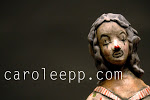by Carole Epp | Jan 4, 2021 | Uncategorized

“By following the health and safety protocols established to allow in-person learning, students in the Ceramics Studio at the Selkirk College Victoria Street Campus are flourishing and appreciating the opportunity to deliver beauty under the shadow of uncertainty.
The wheels of creativity continue to spin at Selkirk College’s downtown Nelson campus where students in School of the Arts craft studio programs have been engaged in hands-on learning since September.
Adhering to the Provincial Health Officer’s COVID-19 pandemic guidelines for safe learning within the post-secondary education system, the Victoria Street Campus is currently offering in-person training for learners in the Blacksmithing Studio, Sculptural Metal Studio, Textiles Studio and Ceramics Studio. With small class sizes and adjusted studio spaces, ten ceramics students are currently putting the final touches on projects as they prepare for the holiday break.
“Creativity at this time is super important,” says student Candace Ferguson, who moved from the Lower Mainland this past summer to attend Selkirk College. “Nobody wants to be in this situation, but allowing creative people to do creative things… it actually gives life to others who enjoy the final outcome and it brings hope. It’s beauty in a place of brokenness.”
Continue reading the full article here: selkirkcollegearts.ca/news/killing-covid-in-the-ceramics-studio/
by Carole Epp | Dec 16, 2020 | Uncategorized
Jeannie Mah will be doing a live chat with Curator Tak Pham during the MacKenzie Art Gallery’s Virtual Opening of HUMAN CAPITAL on Thursday Dec 17 at 7 pm. Join us on the MacKenzie’s Facebook or YouTube accounts!
TRAIN: les ARRIVÉes is an imaginary train journey through history, across Saskatchewan. With family photos of my dad and me at the Willingdon Grocery in Regina, my swimmer pal Lily Tingley’s family at the Broadway Café in Yorkton, and the almost deserted village of Consul, where my father, at age 14, went to school for one year, we traverse Saskatchewan from west to east.
The passenger train, which once connected us from coast to coast, from town to town, from city to beach, has almost vanished, and the labour and lives lost in the construction of the railway seem to have been sacrificed for nothing. From the Last Spike of 1886 to the demise of the passenger train in 1990, we were unable to maintain our national dream for more than 104 years, despite the human cost of the construction of the railway and our nation.
While the video is a delicate present, and the porcelain journey across Saskatchewan is a faded recent “past-present”, the persistent arrival of the train is in contrast to the still images frozen on porcelain, witnesses to the slow disappearance of lives once lived, and the changes to cities and villages, and to lost modes of transportation. Lives remembered, lives sacrificed, lives forgotten.
Travelling towards infinity is at once a moment of departure always in movement towards arrival, just as immigration is a movement between home and away. This continual arrival and departure of presence and memory, of a “coming and going” within the exhibition space, forms the inner cinema of our lives, because of the persistence of memory and vision, of culture and landscape.
Human Capital: MacKenzie Art Gallery. Regina. Dec 17th to April 18th.
TRAIN: les ARRIVÉes was a 2013 solo exhibition at the Godfrey Dean Gallery in Yorkton, initiated by director Don Stein (who I thank for the train video!), reconfigured for this exhibition space.
by Carole Epp | Dec 14, 2020 | job posting
University of Manitoba
Location: Manitoba
Date posted: 2020-12-04
Advertised until: 2021-01-04
The School of Art at the University of Manitoba invites applications for two (2) full-time tenure-track positions at the rank of Assistant Professor commencing July 1, 2021, or as soon thereafter as possible. Salary will be commensurate with experience and qualifications.
This opportunity is open to individuals who self-identify as Indigenous and/or as Black Peoples and/or as members of other racialized groups. Recognizing the underrepresentation of Black, Indigenous, and other racialized faculty in the School of Art, this opportunity is to support the University’s commitment to Employment Equity and has been developed based on the Special Program Provisions of the Manitoba Human Rights Code.
While this call for applications is open, with respect to the artistic practice, we especially welcome applications from those whose creative work is in the areas of Ceramics, Sculpture, and/or Printmaking.
These positions include responsibilities in teaching (undergraduate and graduate), research, and service. We seek candidates with a strong contemporary research program and studio practice, teaching experience, and a record of professional achievement. Candidates must possess a thorough understanding of the contemporary theory and practice of their particular area of creative work, as well as an ability to integrate this expertise into their teaching and research. Ideal candidates will have a demonstrated commitment to visual culture and teaching, student achievement, community engagement, diversity, and inclusion. The successful applicants must hold an MFA or an equivalent terminal degree in a closely related discipline. Applicants should articulate their ability to establish an active research program, and their ability to promote collaborations within the School, across campus, and in the wider community.
This is an exciting opportunity to join a dynamic and innovative education community located on the Fort Garry campus at the University of Manitoba, the province’s larges university, with opportunities for collaborative work with colleagues in the School of Art, in the performing arts (Music and Theatre), as well as other disciplines from across this large U15 institution. The School of Art has 16 full-time faculty and over 300 students. The School of Art is located in the ARTlab, an award-winning, state of the art structure, which houses classrooms and studios for drawing, painting, video, print media, photography, graphic design, and digital media, as well as the School of Art Gallery and Soundstage, an experimental multi-media space. Faculty are also provided an office and studio space in the adjoining Taché Hall building. The School of Art offers excellent opportunities for research, collaboration, and teaching in both graduate and undergraduate programs. The School of Art offers an MFA in studio practice as well as BFA and BFA honours program in studio practice and art history. For further information, please visit the School of Art website: http://www.umanitoba.ca/schools/art.
The University of Manitoba campuses are located on original lands of Anishinaabeg, Cree, Oji-Cree, Dakota, and Dene peoples and on the homeland of the Métis Nation. Creating Pathways to Indigenous Achievement is a key priority for the University, as identified in its 2015-2020 Strategic Plan, Taking Our Place. Home to a vibrant Indigenous community, with more than 2,400 First Nations, Métis, and Inuit students, the U of M has one of the larges Indigenous student populations in the country. Honoured to be chosen as the host of the Nation Centre for Truth and Reconciliation, the U of M is dedicated to advancing Indigenous research and scholarship and to becoming a centre of excellence for this work.
The University is located in Winnipeg, the larges city in the province of Manitoba. The city has a rich cultural environment. The Winnipeg Art Gallery, Plug In ICA, Urban Shaman, aceartinc., and Platform Gallery are among its many exciting gallery venues. The Winnipeg Art Gallery has rich collections of historical and Canadian international art, and a rapidly expanding collection of contemporary Indigenous art; the Inuit Art Centre at the Gallery has the larges collection of modern Inuit art of any public institution in the world. Border Crossings, the Manitoba Museum, the Royal Winnipeg Ballet, Manitoba Opera, and Royal Manitoba Theatre Centre are some of its other cultural institutions. A varied and innovative calendar of cultural festivals with a strong emphasis on the performing arts complements Winnipeg’s rich “brick and mortar” cultural institutions. Winnipeg is also a centre for numerous winter festivals and activities.
The University of Manitoba is strongly committed to equity and diversity within its community and especially welcomes applications from women, racialized persons, Indigenous peoples, persons with disabilities, persons of all sexual and gender identities, and others who may contribute to the further diversification of ideas. All qualified candidates are encouraged to apply; however, Canadian citizens and permanent residents will be given priority.
If you require accommodation supports during the recruitment process, please contact [email protected] or 204-474-7195. Please note this contact information is for accommodation reasons only.
Applications must include the following materials collated into a single PDF document, via email (noted below):
- A cover letter describing what you would bring to the position and how you would contribute to the educational community at the School of Art, (one page);
- Curriculum vitae detailing education, professional background, exhibition history, and teaching record;
- Statement of teaching philosophy, highlighting areas of expertise (one page maximum);
- Statement of research interests (one page maximum);
- Statement of personal understanding of diversity and inclusion, specifically in your pedagogy and artistic practice (one page maximum);
- Up to 20 images of your work and/or up to 20 minutes of time-based work, up to 10 images of your students’ work, and an image checklist with media description. Images should be presented as a single print-ready PDF file; time-based works should be in a .mov/mp4 file format (or provide link and password to a selection of work viewable online—vimeo, you tube, or any other platform);
- Names and contact information for three referees (references will be requested for short-listed candidates);
- Evidence of teaching effectiveness (such as student feedback, course evaluations etc.);
- Sample assignments and/or outlines for any courses or workshops taught; and
- Copies of degrees.
Applications will be accepted until January 22, 2021 or until the positions are filled. Send application materials to:
Dr. Edward Jurkowski, Chair, Search Committee
School of Art, 313 ARTlab
University of Manitoba
180 Dafoe Rd.
Winnipeg, Manitoba Canada, R3T 2N2
[email protected]













